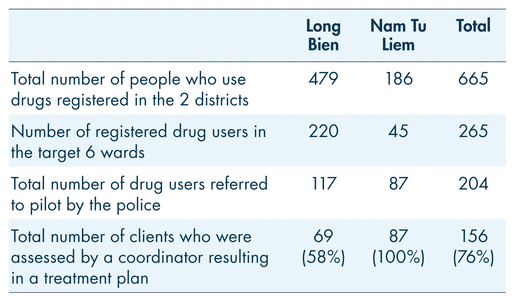
Edna Oppenheimer*, Thuong Nong†, Oanh Khuat‡, Trang Nguyen‡, Xuan Do‡, Van Pham‡
ABSTRACT
The Police Mediated Legal and Social Assistance pilot program was piloted in two districts in Hanoi, Vietnam, between 2018 and 2020. It aimed to strengthen the collaboration between law enforcement and the health and labour sectors and to strengthen the capacity of community services to divert people who use drugs from compulsory residential treatment and support them in accessing medical, social, and legal services in their communities. A total of 204 drug users were referred to treatment and support services by the pilot. Of them, 97 (47%) were referred to methadone clinics and 90 (44%) to recovery support programs, including home-based detoxification and voluntary rehabilitation at state-owned centres. Clients were also assisted in accessing ancillary treatment as needed, such as HIV, tuberculosis, hepatitis, mental health, vocational training, legal aid, and social support. Data indicated a high level of satisfaction from all those involved in the pilot. This pilot is the first collaboration aiming to assist drug users, between law enforcement, community organizations, and the health and welfare sectors. It represents a major shift in the evolving drug policy of Vietnam.
Key Words: Police mediated program, police assistance, collaboration, community-based treatment, voluntary addiction treatment
Since the early 1990s, Vietnam’s official view of illicit drugs has been that they are a “social evil” to be eradicated. Article 61 of the 1992 Constitution (Vietnamese National Assembly, 1992) declared drug addiction a “dangerous social disease.” In response to this problem, the state established drug treatment facilities in 1993. They were “to provide compulsory treatment for drug addiction and certain dangerous social diseases” (Vietnamese Government, 1993).
The Penal Code in 1999 Article 199 (Vietnamese National Assembly, 1999) stated that “those who illegally use narcotics in any form, have been educated time and again and administratively handled through the measure of being sent to compulsory medical treatment establishments but continue to illegally use narcotics, shall be sentenced to between three months and two years of imprisonment and that those who relapse shall be sentenced to between two and five years of imprisonment.”
The Ordinance on Handling of Administrative Violations Article 26 titled “Sending to medical treatment establishments” authorizes district-level People Committee presidents to make the decisions to send persons who used illicit drugs to medical treatment establishments (Vietnamese National Assembly, 2002). Also, Decree 94 added that the time limits for application of the measure of sending to medical treatment establishments shall range from one to two years for drug addicts (Vietnamese Government, 2009).
The subsequent law of 2012, the Law on Handling of Administrative Violations, demonstrated a significant change. Article 104 of this law changed drug use from a criminal offense to an “administrative violation.” In Article 103, the law describes the procedures for the administrative police to record drug use in the community and also states that an addict who is recorded as using drugs for the third time may be sent to compulsory detoxification centres for 12 to 24 months (Vietnamese National Assembly, 2012).
Subsequently, Decree 111 provides further guidance for police chiefs in documenting the profiles of drug users in their communities, which is a part of the procedures for sending people to compulsory detoxification centres. This decree also specifies that the People’s Committee will be notified to allow preparation for social reintegration for people who are released from the centres. The released residents remain registered and supervised by local authorities for at least 2 years after completing their compulsory detoxification (Vietnamese Government, 2013).
In response to United Nations calls for the closure of the compulsory detoxification centres and increasing evidence about the ineffectiveness of the compulsory detoxification provided (Werb et al., 2016), drug use was removed from Vietnam’s Penal Code. A revised policy, the “Renovation Plan on Drug Treatment” (2013), sought to further reduce the number of drug users detained in compulsory drug detoxification centres from 63% in 2013 to just 6% by 2020 (Kamarulzaman & McBrayer, 2015) and to increase support for community-based treatment and for developing voluntary options within the compulsory detoxification facilities. This represents a significant policy change.
In April 2014, the Secretariat of the Communist Party Central Committee called for an improvement in the quality of state compulsory detoxification centres, transforming them into treatment facilities using a variety of treatment models.
Data from MOLISA (Ministry of Labour, Invalids and Social Affairs) in April 2020 indicated that Vietnam has 97 public drug detoxification facilities, treating 34,982 patients, plus 16 additional approved voluntary drug detoxification facilities countrywide. So far, there are only 13 provinces and cities in Vietnam where family- and community-based detoxification exist (Hieu et al., 2021).
The HIV epidemic further shifted official perception of the drug problem, and the “harm-reduction” approach was gradually introduced. As a result, the Law on AIDS/HIV Prevention and Control was issued in 2006, emphasizing the “encouragement of the use of clean syringes and needles, treatment of addiction to opium-related substances with substitute substances, and other harm reduction intervention measures.”
The first opioid substitution clinic which dispensed methadone was opened in 2008, with the first pilot clinics opening in Haiphong and Ho Chi Minh City in August 2008 and Hanoi in December 2009. By March 2017, Vietnam had 280 methadone clinics nationwide and plans to scale up the coverage of MMT (Methadone Maintenance Treatment) programs with a target of 80,000 people who use drugs (PWUD) (Le et al., 2020).
Although the Ministry of Health is mandated by the government to provide technical medical guidelines for the treatment of substance use disorders, the management, planning, and implementation of treatment in drug rehabilitation facilities and in the community are MOLISA’s responsibility.
Even though drug use is no longer criminalized in Vietnam, it is still considered a major public security issue. The 2021 Law on Drug Control has an updated chapter on the management of people who use illicit drugs, in which the police were assigned the responsibility of making the list of PWUD and managing them in the locality.
The Department of Administrative Management for Public Order (Administrative Police) under the Ministry of Public Security is the police force responsible for all aspects of administrative management of Vietnamese citizens by the police. This includes issuing identification papers, maintaining household address books and a national data system of citizens, and other administrative measures. This police force is responsible for monitoring and managing all the residents in each neighbourhood. Therefore, detection of PWUD and the compilation of dossiers to send them to compulsory detoxification centres also fell under the responsibility of the administrative police.
The pilot was implemented according to the plan of Hanoi’s People Committee. The Centre for Supporting Community Development Initiatives (SCDI) was chosen as a partner of Hanoi city to implement the plan, and they worked closely with Hanoi’s Department of Social Vices Prevention to support the establishment of the model.
The pilot targeted PWUD who were known to and monitored by the administrative police. For example, the target groups included those who tested positive for drugs on 3 occasions and those recently discharged because they had a high possibility of being sent to the compulsory detoxification centres.
The pilot took place in Hanoi (Long Bien district: Wards Ngoc Thuy, Bo De, and Ngoc Lam; Nam Tu Liem district: My Dinh 1, Cau Dien, and Xuan Phuong wards) and consisted of 2 phases: May 2018 to May 2019 (sensitization and preparation) and May 2019 to June 2020 (implementation and expansion).
The pilot aimed to develop a community drug treatment network which will:
▪ Strengthen collaboration and coordination between the Departments of Public Security, MOLISA, and the Departments of Health in facilitating access to medical, social, and legal services to include collaboration at the local level.
▪ Mediate the existing process of automatically sending drug users (who tested positive for drugs on more than three occasions over a 3-month period) directly to compulsory detoxification, by referring the drug user to a coordinator who will assess the situation and help the client find the most appropriate treatment.
▪ Create opportunities for early access and treatment to both drug detoxification and comprehensive rehabilitation in the community, reducing social, legal, and health harms.
▪ Increase the number of drug users in treatment and detoxification, reduce the number of compulsory detoxifications, and increase the effectiveness of treatment
▪ Reduce the negative consequences of drug use by decreasing relapse and repeat offending and reducing the risk of HIV, Hepatitis B and C, and tuberculosis (TB).
Training was offered by SCDI and included various topics, such as the science of addiction treatment, referral systems, screening procedures and tools, treatment planning, counselling skills, case management, and data collection. Learning visits to other sites, including a visit to a hospital-based addiction treatment facility in Chiang Mai, Thailand, and another visit to community-based addiction treatment units in Khanh Hoa province, Vietnam, were also organized for the pilot’s key participants.
Police officers were the most important change maker in the pilot compared with common practice everywhere else in Vietnam. They were the front-liners who detected and first came into contact with PWUD by monitoring their areas. Their original main task was to make dossiers to send PWUD to compulsory detoxification centres. In this pilot, their assigned task was changed to referring PWUD they had identified to the ward’s coordinator for health, social, and legal support. This change was possible because the pilot had already been approved beforehand by Hanoi People’s Committee. The police also kept constant communication with coordinators to follow up on clients’ progress to update in their monitoring system.
Coordinators were the pivotal figures in this project. They were usually volunteers for social activities in the ward or “social affairs” staff members who had been assigned the additional task of coordinator by the ward authorities. Each of the 6 participating wards had one coordinator who was experienced in the drug field and might be acquainted with their clients. Their task was to assess clients, refer, support, and follow up, with referral to ancillary health, social, or legal services as needed. The coordinators worked closely with, and received support from, senior law enforcement personnel, administrative police, counsellors, and recovery coaches. Coordinators worked part-time for the pilot. On average, they spent 10 to 14 hours to support and follow 8 to 10 clients per month. The average case load was around 30 per ward.
The counsellors (two) were selected by the piloted districts based on the availability and suitability of human resources in the district personnel. One of them was a counsellor working at the district’s health centre and the other one was a member of the social affairs staff. Their responsibility was to cooperate with the coordinators to provide counselling sessions with the clients and monitor the progress of their recovery.
Recovery coaches (two), one in each district, were trained and were recruited by SCDI to provide peer recovery support for the pilot’s clients. They were ex-PWUD based in the districts implementing the pilot and considered community leaders who had been providing harm reduction services for PWUD in their areas for a long time.
A total of 204 PWUD, including 2 women, were referred to the pilot out of a total of 265 registered PWUD known to the authorities. There were 117 referrals from Long Bien district and 87 from Nam Tu Liem district (Table I).
TABLE I Drug users in Long Bien and Nam Tu Liem districts/6 wards

In total, 160 (78%) completed the Alcohol, Smoking and Substance Involvement Screening Test (ASSIST) forms (Humeniuk et al., 2010) to provide information on their current drug use. According to the ASSIST assessment:
▪ 111 (54%) were heroin users and 49 (24%) were injectors.
▪ 37 (18%) used methamphetamine
▪ 79 (38%) used alcohol.
▪ 6 clients used cannabis, 4 – cocaine, 12 – minor sedatives, and 6 – hallucinogens.
In Vietnam, in general, PWUD identified by the police are sent to compulsory rehabilitation centres. However, community-based treatment became a priority in the context of this pilot. During the pilot, clients and coordinators discussed all available options, including opioid substitution treatment, home-based detoxification, voluntary residential treatment, and psychiatric hospitals. Voluntary residential treatment is usually for 3 months, and clients opting for this program have to pay 30% of the cost while the rest is covered by the government.
In total, 28 (14%) and 12 (6%) clients left the pilot in Long Bien and Nam Tu Liem, respectively. The main reason for the dropout was because the clients moved out of the piloting wards.
Most clients were offered additional services and referrals to health services. By the end of June 2020, the model reached a total of 204 clients. Table II summarizes the referrals provided.
▪ 204 clients were reached and provided with screening and brief interventions
▪ 97 clients were referred to HIV testing and prevention services
▪ 97 clients were referred to methadone treatment
▪ 6 clients were referred to mental health services
▪ 90 clients were referred to recovery support (including detoxification at home, or at rehabilitation centres for 20 days, 3 months, and 6 months)
▪ 62 clients were provided legal aid
▪ 4 clients were provided vocational training and employment opportunities
▪ 2 clients were offered other supports
TABLE II Summary of client referrals to treatment by district (May 2019–June 2020)
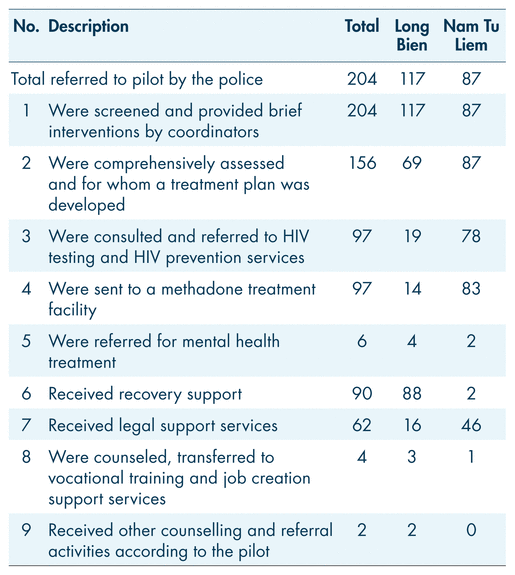
In addition, during the COVID-19 pandemic, 33 poor clients taking part in the pilot received food packages to help them through difficult times. All the clients and staff of the pilot also received a total of 370 bottles of hand sanitizer and 1,450 face masks in response to the COVID-19 waves in Hanoi.
One year after implementation, in May 2020, an evaluation was conducted to collect qualitative and quantitative data from the pilot. In-depth interviews with 16 clients, coordinators, counsellors, police officers, and representatives of the ward’s People’s Committee were conducted to collect qualitative data. The quantitative data was collected by using questionnaire surveys with the pilot’s clients. The evaluation planned to survey all the clients of the pilot. However, it was finally reduced to 75 clients due to the COVID-19 wave in Hanoi during the evaluation time.
A more detailed account of the lifetime drug use and treatment history was obtained for 75 clients:
▪ Heroin: 64 (85%) had a history of heroin use; 42 (56%) were injectors; 24 (33%) smoked; and 8 (11%) snorted heroin. The average age of first use was 25 (range 23–61). The average frequency of heroin use prior to the project was 20 times per month.
▪ Synthetic drugs: 21 (28%) had a history of synthetic drug use. The mean age of starting use was 31.
▪ Cannabis: 8 (11%) clients had used cannabis. The average age of first use was 22. No clients reported the use of ketamine or of any other type of drugs.
▪ Alcohol: 42 (57%) of the surveyed clients drank alcohol. The average age of starting use was 18.
In all, 51 (68%) of clients underwent compulsory detoxification an average of 1.5 times (range 1–4 years) for a mean period of 3 years (range 1–6 years). The length of abstinence following compulsory detoxification ranged from 0 to 16 years (mean 3 years). However, the majority of clients relapsed in the first year after discharge.
The questionnaire survey with 75 clients of the pilot also reported types of services that clients received. A summary of referral patterns for 75 clients indicated that testing for HIV was offered to 85%, hepatitis B and C testing to 81%, and assistance for mental health issues to 68%; 23% of clients received post-treatment support from pilot staff (Table III).
TABLE III Summary of services offered and used during the pilot (N =75)
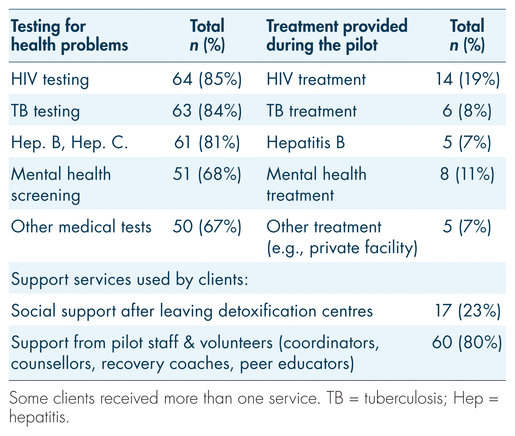
Perceptions of the help provided by both were overwhelmingly positive. The opportunity to discuss treatment options was appreciated, as was the inclusion of counsellors in the process (which occurred in Nam Tu Liem district). The majority of clients were appreciative of the help provided by the counsellors, 84% expressing appreciation that the counsellor explained treatment options and continued to monitor their progress (Tables IV, V).
TABLE IV Clients’ perceptions of support from coordinators (N =75)
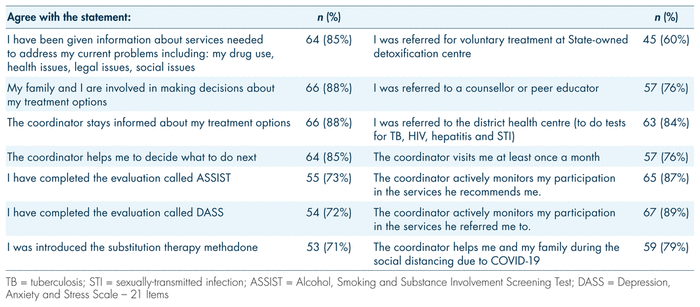
TABLE V Clients’ perceptions of support from counsellors (N =75)
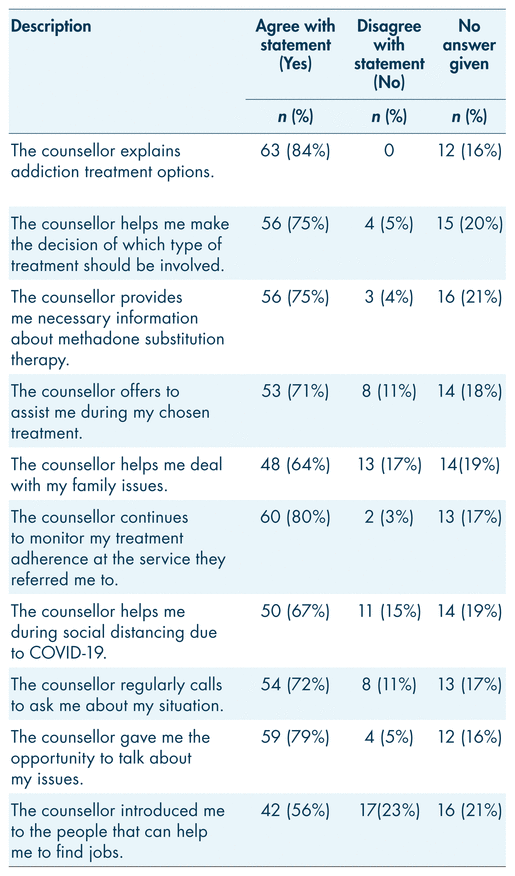
Many clients (68%) said that they had had little contact with the police in the previous 12 months. However, 88% noted that they were less afraid of being noticed by the police, and 81% said that the police attitude to PWUD had changed in a positive direction (Table VI).
TABLE VI Clients’ perceptions of the police (N =75)
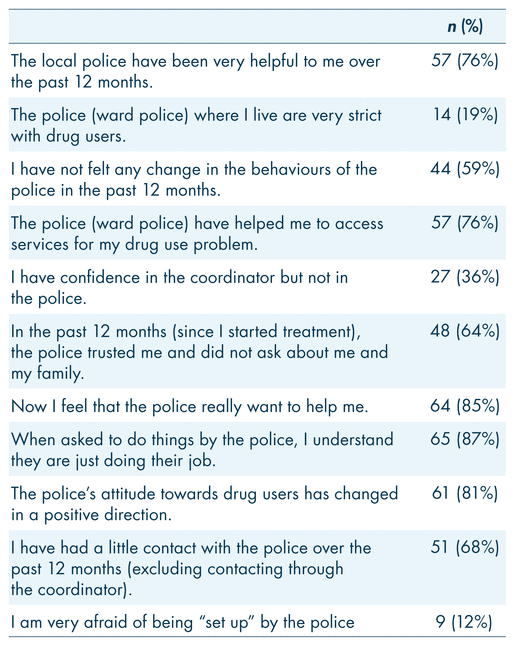
Most clients highly rated the quality of services provided: 71% said it was “good” and 27% rated it “excellent.” The majority (77%) reported that their basic needs had been largely met, and a further 16% said that “almost all” of their needs were met. Clients’ overall evaluation of the model indicated that 43% were “satisfied” and 51% were “very satisfied.” Only 3% said they were “relatively” or just “somewhat” satisfied (Table VII, VIII).
TABLE VII Quality of the service
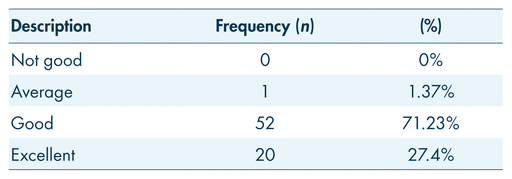
Interviews took place over 1 week in May 2010 in the offices of the People’s Committees.
The government officials included management from districts and wards, the People’s Committees, Department of Labour, Invalids and Social Affairs, Department of Social Vices Prevention, and administrative police officers.
All expressed full support for this new initiative, saying that it was “very feasible,” “human and convincing,” and they supported its expansion. They highlighted the need for more investment in the health, welfare, and legal infrastructure to support this model. They noted that most subjects of this initiative were PWUD already known to the authorities, and that new young users, many of whom were ATS (amphetamine-type stimulants) users, were not yet included. Opinions expressed included:
“In my opinion, one year is not a long time but I can see many positive things of the model. If It is replicated in other areas, it will be very good.”
“After one year of project implementation, from the management as well as personal aspect, I highly appreciate it—especially in getting to know and understand the patients so that we can support them.”
All administrative police officers provided positive feedback and were comfortable changing their modus operandi, working with the coordinators to provide treatment options. During the pilot, only those who re-used drugs and did not adhere to community treatment were referred directly to the compulsory centres. Those with no fixed address were also sent directly to these centres. Several officers remarked that some families insisted on the compulsory centres option, believing it to be the only helpful treatment. Some commented that the pilot reduced bureaucracy and lightened their workload. One said: “The pilot has added to our knowledge and awareness about drug issues and about potential services. We are satisfied to be able to help PWUD access a host of ancillary services to help them in their recovery and rehabilitation.”
In all 6 wards, there was unanimous praise for the pilot and acknowledgement that dealing with PWUD by encouraging trust and consultation is a good way forward. Coordinators noted that the referral process was unclear and unsystematic and acknowledged their lack of experience in assessing clients’ needs and treatment options. Some sought the help of counsellors. Although the training was offered by SCDI, coordinators said that it was insufficient and did not fully prepare them for their tasks. They felt that more training was necessary.
Both observed that the project should have more professional counselling staff and mobilize community peervolunteersandpeereducators. Alargerpoolofcounselling/recovery staff was needed to support the PWUD included in the pilot. They reported a lack of clarity about their roles and that the assessment process was inadequate and not fully realized.
All clients were selected by the coordinators and asked to come to the People’s Committee office to be interviewed. All were well known to the police and had a long association with law enforcement. Among them, 12 of the 16 had been in compulsory centres. Most were currently attending a methadone clinic. All were unaware of the pilot and did not recognize it as a new initiative. Some, but not all, had been formally assessed before inclusion in the pilot. All were long-term PWUD. Most were primarily heroin users but also using ATS. Only 2 were primarily ATS users, and both displayed delusional behaviours during the interview (neither was receiving specialized treatment). Some respondents were already methadone patients at intake but, during the pilot, were offered additional help to access ancillary services, as needed. Overall, the coordinator was viewed positively, but previous (and current) experiences with law enforcement led some PWUD to be suspicious of the coordinators.
Interviewees reported that police continued to act independently during the pilot, pursuing their obligation to test those suspected of using illegal drugs. These efforts often centred around the methadone clinics. Views on the police remained ambivalent. The police remained a regular presence in their lives. Some had help with obtaining health insurance and identification papers.
The overall impression from interviewing these clients was that the changes introduced by the pilot were not explained or recognized although clients may well have benefited from the new approach. Overall, they made no complaints and reported satisfaction with their current engagement with law enforcement and with health and community services.
This report showcases a new approach to the treatment of PWUD in Vietnam. It was implemented in just 6 wards in 2 districts in Hanoi. The pilot represents a major policy shift by promoting police-mediated legal and social assistance to PWUD whereas previously the role of the police was confined to recording, supervising, and apprehending people who violate the drug laws and sending them to compulsory treatment when they do.
The approach piloted here is spearheaded by law enforcement, supported by health and welfare services, and predicated upon the availability of alternative community-based voluntary drug treatment. The pilot allowed PWUD and their families to consider the most appropriate treatment depending on their situation and, wherever possible, allowing PWUD to remain with their families and in their communities. Indeed, in one of the two districts, no one was referred to residential or compulsory treatment. Feedback and reflections on the pilot are crucial for the future development of drug policy in Vietnam. Reflections and comments from both the pilot implementers and the clients indicated significant satisfaction and approval of the approach and the expressed recommendation that this approach should be extended to other parts of Vietnam.
It is important to note, however, that for the approach to be successful, much needs to be done both in the community and among relevant professionals to increase the workforce and upgrade their understanding and skills to provide assistance and rehabilitation to PWUD. There was universal endorsement of the approach by all stakeholders, all of whom expressed the view that this approach should be extended to the rest of the country.
This pilot is a “work in progress,” and much needs to be done to improve and systematize this approach. Beginning with an extension and improvement of training and capacity building, there is little doubt that the counselling services should be considerably increased and that the assessment procedures should be streamlined and improved. A systematic and clear approach to data gathering is essential if legislators are to be convinced about the efficacy of this approach. So too, efforts should be made to raise awareness in the community about drug use and drug services. It was clear that many PWUD and their families were unclear about the role and objectives of the methadone program, and the idea of “maintenance” was unclear and rejected. Future interventions should include better systems of data gathering and analysis, vigorous evaluation of the methodology and procedures, analysis of outcomes, and assessments of community sentiments about the approach.
First and foremost, the authors would like to acknowledge the support of the Substance Abuse and Mental Health Services Administration (SAMHSA), United States, to implement this initiative in Vietnam. We are grateful to the Department of Social Vices Prevention of Hanoi, the Department of Social Affairs of the pilot districts for their cooperation in implementing the pilot model in Hanoi, and their support in organizing the evaluation. Last but not least, we would like to thank the site’s coordinators and the participants of the evaluation for their assistance in survey implementation and data collection.
The authors declare that there are no conflicts of interest.
*Independent Consultant at SCDI, Hanoi, Vietnam,
†Thuong Nong, Brandeis University, Waltham, MA, USA,
‡Centre for Supporting Community Development Initiatives (SCDI), Hanoi, Vietnam.
Hieu, D. M., Gray, B., Tuan, D. M., Colman, B. P. (2021). Facing drug addiction: Vietnam’s struggle with opioids. Drug Science, Policy and Law, 7, 20503245211034936. https://doi.org/10.1177/20503245211034934
Crossref
Humeniuk, R., Henry-Edwards, S., Ali, R., Poznyak, V., Monteiro, M. G., World Health Organization. (2010). The Alcohol, Smoking and Substance involvement Screening Test (ASSIST): Manual for use in primary care. World Health Organization. https://apps.who.int/iris/handle/10665/44320
Kamarulzaman, A., McBrayer, J. L. (2015). Compulsory drug detention centres in East and Southeast Asia. The International Journal on Drug Policy, 26(Suppl 1), S33–37. https://doi.org/10.1016/j.drugpo.2014.11.011
Crossref
Le, T. A., Nguyen, T. A., Dang, A. D., Nguyen, C. T., Phan, H. T., Vu, G. T., Nguyen, T. H. T., Latkin, C. A., Ho, C. S. H., Ho, R. C. M., Tran, B. X., Ying, J., Zhang, M. W. B. (2020). Preferences for methadone clinics among drug users in Vietnam: A comparison between public and private models. Harm Reduction Journal, 17(1), 1. https://doi.org/10.1186/s12954-019-0355-x
Crossref PubMed PMC
Vietnamese Government. (1993). The centres thus established became known as the 06 (Decree 06/CP).
Vietnamese Government. (2009). Detailed regulations for the implementation of a number of articles on post-detoxification management in the law amendment on drug prevention and control (Decree 94/2009/ND-CP).
Vietnamese Government. (2013). Regulations on the application of administrative measures of education in communes, wards and township of residence (Decree 111/2013/ND-CP). https://thuvienphapluat.vn/van-ban/Vi-pham-hanh-chinh/Nghi-dinh-111-2013-ND-CP-xu-ly-hanh-chinh-giao-duc-xa-phuong-thi-tran-209091.aspx
Vietnamese National Assembly. (1992). Vietnam Constitution. https://vietnam.gov.vn/constitution-1992-68962
Vietnamese National Assembly. (1999). The Penal Code. https://sites.google.com/a/ecolaw.vn/luat-tienwg-anh/1-bo-luat-luat/-penal-code-of-viet-nam-1999
Vietnamese National Assembly. (2002). On handling of administrative violations (Ordinance No. 44/2002/PL-UBTVQH10).
Vietnamese National Assembly. (2012). Law on Handling of Administrative Violations (No. 15/2012/QH13). http://img2.caa.gov.vn/2016/07/28/02/34/152012-Law-on-handling-adminstrative-violations.pdf
Werb, D., Kamarulzaman, A., Meacham, M. C., Rafful, C., Fischer, B., Strathdee, S. A., Wood, E. (2016). The effectiveness of compulsory drug treatment: A systematic review. The International Journal on Drug Policy, 28, 1–9. https:/w/doi.org/10.1016/j.drugpo.2015.12.005
Crossref PubMed PMC
This work is licensed under the Creative Commons Attribution-NonCommercial-NoDerivatives 4.0 International License. To view a copy of this license, visit http://creativecommons.org/licenses/by-nc-nd/4.0/. For commercial re-use, please contact sales@sgpublishing.ca.
Journal of CSWB, VOLUME 7, Suppl 1, July 2022